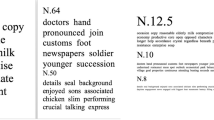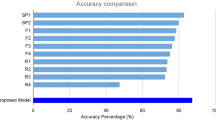Abstract
Background
Home monitoring of hyperacuity allows early detection of progression in exudative neovascular age-related macular degeneration (nvAMD) and diabetic macular oedema (DMO). However, false alarms may pose a significant burden to both patients and healthcare professionals alike.
Purpose
To assess the false alarm rate and positive predictive value of smartphone-based home monitoring of nvAMD and DMO.
Methods
Patients treated with anti-angiogenic therapy in a pro re nata scheme for nvAMD or DMO at the Medical Retina service (Lucerne, Switzerland) between March and June 2016 were included in this prospective cohort study. The home monitoring test Alleye (Oculocare Ltd, Switzerland) provided a session score from 0–100 in addition to a traffic-light system feedback via the smartphone application. Three consecutive “red” scores were considered as a positive test or alarm signal. Specificity, 1-specificity (false alarm rate) and the predictive value for optical coherence tomography-based disease progression were analysed.
Results
73 eyes of 56 patients performed 2258 tests in 222 “follow-up periods”. Progression was observed in 141 periods (63.5%). The specificity of the test was 93.8% (95% CI: 86.2–98.0%), the false alarm rate 6.1% (95% CI: 2.0–13.8%), and the positive predictive value 80.0% (95% CI: 59.3–93.2%) for the detection of progression.
Conclusion
False alarm rates for the detection of progression in macular disease via home monitoring is low. These findings suggest that home monitoring may be a useful adjunct for remote management of nvAMD and DMO.
Similar content being viewed by others
Log in or create a free account to read this content
Gain free access to this article, as well as selected content from this journal and more on nature.com
or
Change history
31 March 2021
A Correction to this paper has been published: https://doi.org/10.1038/s41433-021-01512-2
References
Mehrotra A, Chernew M, Linetsky D, Hatch H, Cutler D. The impact of the COVID-19 pandemic on outpatient visits: a rebound emerges,” To the Point (blog). Commonwealth Fund. 2020; https://doi.org/10.26099/ds9e-jm36.
Faes L, Bachmann LM, Sim DA. Home monitoring as a useful extension of modern tele-ophthalmology. Eye (Lond). 2020;34:1950–3.
Kang S, Thomas PBM, Sim DA, Parker RT, Daniel C, Uddin JM. Oculoplastic video-based telemedicine consultations: Covid-19 and beyond. Eye (Lond). 2020;34:1193–5.
Kern C, Fu DJ, Kortuem K, Huemer J, Barker D, Davis A, et al. Implementation of a cloud-based referral platform in ophthalmology: making telemedicine services a reality in eye care. Br J Ophthalmol. 2020;104:312–7.
Kortuem K, Fasler K, Charnley A, Khambati H, Fasolo S, Katz M, et al. Implementation of medical retina virtual clinics in a tertiary eye care referral centre. Br J Ophthalmol. 2018;102:1391–5.
Faes L, Bodmer NS, Bachmann LM, Thiel MA, Schmid MK. Diagnostic accuracy of the Amsler grid and the preferential hyperacuity perimetry in the screening of patients with age-related macular degeneration: systematic review and meta-analysis. Eye. 2014;28:788–96.
Schmidt-Erfurth U, Chong V, Loewenstein A, Larsen M, Souied E, Schlingemann R, et al. Guidelines for the management of neovascular age-related macular degeneration by the European Society of Retina Specialists (EURETINA). Br J Ophthalmol. 2014;98:1144–67.
Simunovic MP. Metamorphopsia and its quantification. Retina. 2015;35:1285–91.
Crossland M, Rubin G. The Amsler chart: absence of evidence is not evidence of absence. Br J Ophthalmol. 2007;91:391–3.
Kaiser PK, Wang YZ, He YG, Weisberger A, Wolf S, Smith CH. Feasibility of a novel remote daily monitoring system for age-related macular degeneration using mobile handheld devices: results of a pilot study. Retina. 2013;33:1863–70.
Schmid MK, Faes L, Bachmann LM, Thiel MA. Accuracy of a self-monitoring test for identification and monitoring of age-related macular degeneration: a diagnostic case-control study. Open Ophthalmol J. 2018;12:19–28.
Schmid MK, Thiel MA, Lienhard K, Schlingemann RO, Faes L, Bachmann LM. Reliability and diagnostic performance of a novel mobile app for hyperacuity self-monitoring in patients with age-related macular degeneration. Eye. 2019;33:1584–9.
Goldstein M, Loewenstein A, Barak A, Pollack A, Bukelman A, Katz H, et al. Results of a multicenter clinical trial to evaluate the preferential hyperacuity perimeter for detection of age-related macular degeneration. Retina. 2005;25:296–303.
Midena E, Vujosevic S. Metamorphopsia: an overlooked visual symptom. Ophthalmic Res. 2015;55:26–36.
Schwartz R, Loewenstein A. Early detection of age related macular degeneration: current status. Int J Retin Vitreous. 2015;1:20.
Alster Y, Bressler NM, Bressler SB, Brimacombe JA, Crompton RM, Duh YJ, et al. Preferential hyperacuity perimeter (PreView PHP) for detecting choroidal neovascularization study. Ophthalmology. 2005;112:1758–65.
Isaac DL, Avila MP, Cialdini AP. Comparison of the original Amsler grid with the preferential hyperacuity perimeter for detecting choroidal neovascularization in age-related macular degeneration. Arquivos brasileiros de oftalmologia. 2007;70:771–6.
Loewenstein A, Malach R, Goldstein M, Leibovitch I, Barak A, Baruch E, et al. Replacing the Amsler grid: a new method for monitoring patients with age-related macular degeneration. Ophthalmology. 2003;110:966–70.
Faes L, Bachmann LM, Schmid MK, Thiel MA. The diagnostic accuracy of the patient self-test Alleye to detect diabetic macular edema. ePoster EURETINA. 2019: 117.
Thomas M, Wolfson Y, Zayit-Soudry S, Bressler SB, Bressler NM. Qualifying to use a home monitoring device for detection of neovascular age-related macular degeneration. JAMA Ophthalmol. 2015;133:1425–30.
Markun S, Dishy A, Neuner-Jehle S, Rosemann T, Frei A. The chronic care for wet age related macular degeneration (CHARMED) study: a randomized controlled trial. PLoS One. 2015;10:e0143085.
Keane PA, de Salvo G, Sim DA, Goverdhan S, Agrawal R, Tufail A. Strategies for improving early detection and diagnosis of neovascular age-related macular degeneration. Clin Ophthalmol. 2015;9:353–66.
Author information
Authors and Affiliations
Corresponding author
Ethics declarations
Conflict of interest
LMB, KL, and MKS are founders of Oculocare medical Inc., which develops innovative products in eye care, such as the self-monitoring test described in this paper. The other authors declare that they have no conflict of interest.
Additional information
Publisher’s note Springer Nature remains neutral with regard to jurisdictional claims in published maps and institutional affiliations.
The original online version of this article was revised due to a retrospective Open Access cancellation.
Rights and permissions
About this article
Cite this article
Faes, L., Islam, M., Bachmann, L.M. et al. False alarms and the positive predictive value of smartphone-based hyperacuity home monitoring for the progression of macular disease: a prospective cohort study. Eye 35, 3035–3040 (2021). https://doi.org/10.1038/s41433-020-01356-2
Received:
Revised:
Accepted:
Published:
Issue date:
DOI: https://doi.org/10.1038/s41433-020-01356-2
This article is cited by
-
Digitale Telemedizin zur Überwachung chronischer Netzhauterkrankungen – ein klinisches Werkzeug für die Zukunft?
Die Ophthalmologie (2024)
-
Digital Exclusion, Social Deprivation, and Clinical Outcomes of Patients Undergoing Hyperacuity Home Monitoring
Ophthalmology and Therapy (2024)
-
System usability, user satisfaction and long-term adherence to mobile hyperacuity home monitoring—prospective follow-up study
Eye (2023)
-
Transforming ophthalmology in the digital century—new care models with added value for patients
Eye (2023)
-
Perspectives on the Home Monitoring of Macular Disease
Ophthalmology and Therapy (2023)



